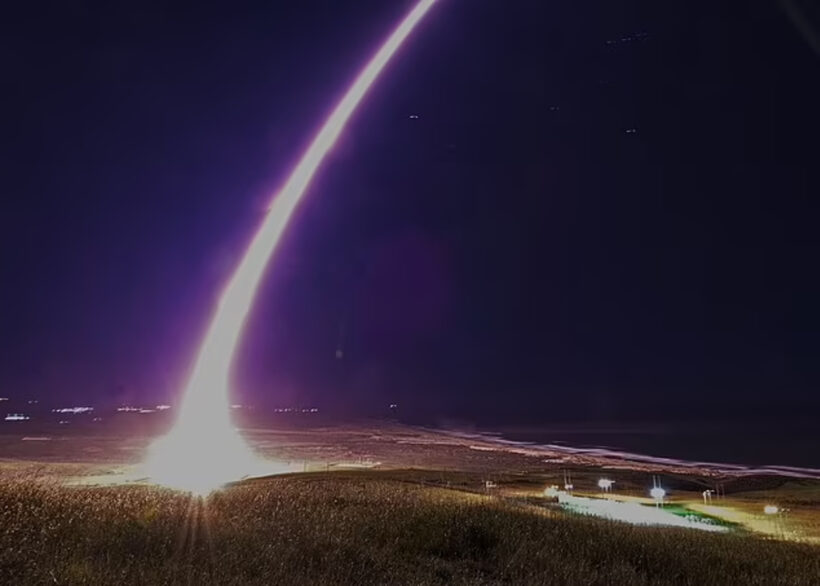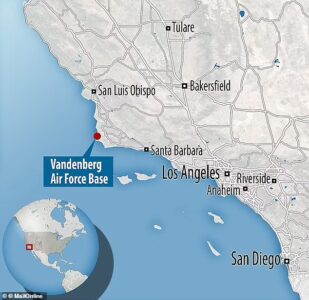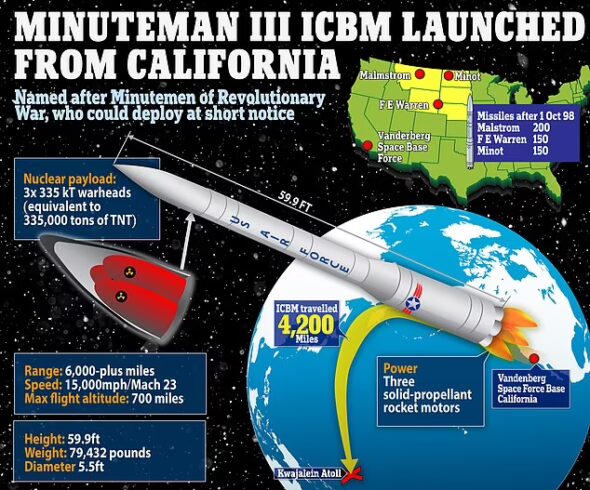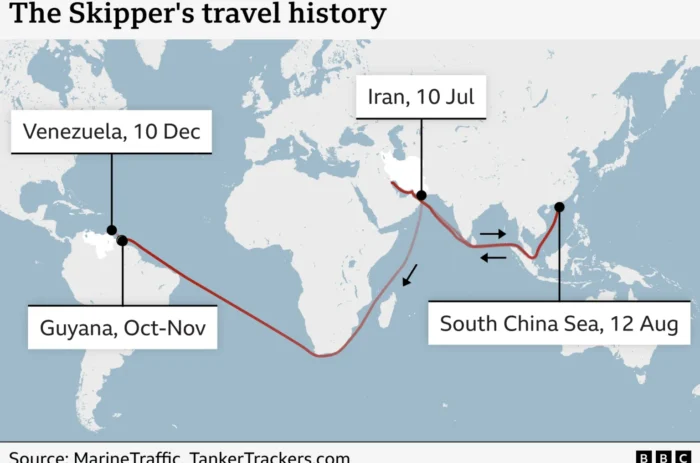
Stunning photo of the launch showed the missile cut a huge bright arc across the night sky early February 19, 2025 (UK Daily Mail)
redo Jump to...
print Print...
(by Mike Heuer, UPI) – The U.S. Air Force demonstrated the nation’s nuclear readiness by launching an unarmed Minuteman III intercontinental ballistic missile from Vandenberg Space Force Base in California early Wednesday morning.
The test launch occurred shortly after Russia test-launched its Yars ICBM missile, and the Minuteman III completed a 4,200-mile course in about 22 minutes at a speed of 15,000 mph and splashed down at a test range near the Kwajalein Atoll in the Pacific Ocean, the Daily Mail reported.
“Today’s Minuteman III test launch is just one of the ways the Department of the Air Force demonstrates the readiness, precision and professionalism of U.S. nuclear forces,” Acting Secretary of the Air Force Gary Ashworth said in an online announcement.
“It also provides confidence in the lethality and effectiveness of the nation’s nuclear deterrence mission,” Ashworth said.
The launch occurred at 1 a.m. from the base that is located in California’s Santa Barbara County and is intended to “demonstrate the readiness of U.S. nuclear forces and provide confidence in the lethality and effectiveness of the nation’s nuclear deterrent,” the Air Force Global Strike Command said ahead of the planned launch.
“This test is routine and was scheduled years in advance,” the AFGSC said. “Consistent with previous test launches, this ICBM test launch will validate and verify the effectiveness, readiness and accuracy of the weapon system.”
U.S. officials transmitted pre-launch notification of the test-launch to 140 nations in accordance with the Hague Code of Conduct and notified the Russian government as required by bilateral agreements between the two nations.
The Minuteman III ICBM is a hypersonic missile capable of traveling at a speed equal to at least five times the speed of sound and is capable of striking Moscow within 30 minutes of its launch.
It can carry up to three nuclear warheads and can reach targets more than 6,000 miles distant, the Los Angeles Times reported.
T he missile has a maximum speed of 15,000 mph, measures nearly 60 feet in length and weighs about 80,000 pounds.
he missile has a maximum speed of 15,000 mph, measures nearly 60 feet in length and weighs about 80,000 pounds.
While in flight, three solid rocket fuel engines power the missile, which follows a curved trajectory before releasing its warheads to strike their intended targets.
[The Air Force’s arsenal of roughly 400 Minuteman III ICBMs is a crucial component of the nation’s nuclear triad, along with bombers and submarines that can also carry and deploy nuclear weapons].Published at United Press International (UPI) on Feb. 19. Reprinted here for educational purposes only. May not be reproduced on other websites without permission.
Questions
1. What is the difference between an intercontinental ballistic missile (ICBM) and a ballistic missile?
2. The first paragraph of a news article should answer the questions who, what, where and when. List the who, what, where and when of this article. (NOTE: The remainder of a news article provides details on the why and/or how.)
3. How far, how fast and how long did the Minuteman III ICBM travel?
4. What is the purpose of the test of the Minuteman III?
5. a) Why did the Air Force conduct this test now?
b) Who did US officials notify? Why did they do so?
6. What additional information do you learn about the Minuteman III in this article?
7. Read the “Background” below and watch the videos under “Resources.” Then read the following from a Google Generative AI search result for “difference between Reagan’s SDI and an Iron Dome System”:
The United States has several systems that are similar to Israel’s Iron Dome air defense system, including the Terminal High Altitude Area Defense (THAAD) system, Patriot missile batteries, and the Indirect Fire Protection Capability (IFPC) system.
Similar systems
- THAAD: A system that intercepts incoming missiles during their descent phase
- Patriot: A system that intercepts missiles at a lower altitude
- IFPC: A system that includes the IFPC High-Energy Laser and IFPC High-Powered Microwave
Marine Air Defense Integrated System (MADIS): A mobile system that uses a truck-mounted Iron Dome launcher
Defense strategy
The US military has a layered defense strategy that includes these systems and others. The US policy is to defend its citizens and critical infrastructure from foreign aerial attacks.
Iron Dome in Israel
The Iron Dome is an Israeli air defense system that intercepts short-range rockets and shells. The US supported the development of the Iron Dome.
Trump’s proposal
President Trump proposed an “Iron Dome for America” that would include space-based interceptors. However, some experts have dismissed this proposal as impractical.
a) How important do you think it is for the US to not only have these nuclear missiles, but an Iron Dome?
b) Google results note: President Donald Trump proposed an “Iron Dome for America” that would include space-based interceptors. However, some experts have dismissed this proposal as impractical. What do you think?
c) Ask a parent the same questions (a and b)
Background
An intercontinental ballistic missile (ICBM) is a guided ballistic missile with a minimum range of 3,400 miles primarily designed for nuclear weapons delivery [delivering one or more thermonuclear warheads] wikipedia
A ballistic missile is a missile that follows a sub-orbital ballistic flightpath with the objective of delivering one or more warheads (often nuclear) to a predetermined target. The missile is only guided during the relatively brief initial powered phase of flight and its course is subsequently governed by the laws of orbital mechanics and ballistics. To date, ballistic missiles have been propelled during powered flight by chemical rocket engines of various types. (from wikipedia)
THE U.S. MISSILE-DEFENSE SYSTEM:
The Strategic Defense Initiative (SDI) was proposed by U.S. President Ronald Reagan on March 23, 1983 to use ground-based and space-based systems to protect the United States from attack by strategic nuclear ballistic missiles. The SDI was intended to defend the United States from attack from Soviet ICBMs by intercepting the missiles at various phases of their flight.
The initiative focused on strategic defense rather than the prior strategic offense doctrine of mutual assured destruction (MAD), that assumed that neither side would start a nuclear war because it would not be able to avoid imminent destruction. Reagan’s “Star Wars” program drew the Soviets into a costly effort to mount a response. The race depleted Soviet funds and triggered the economic difficulties that led to the collapse of the Soviet Union in 1991. (Many in the media and liberal circles ridiculed President Reagan for being a warmonger AND a dunce; they did not understand the necessity of a missile defense system).
On Jan. 27, 2025, President Trump signed an Executive Order to “Direct the Building of the Iron Dome Missile Defense Shield for America.”
The Executive Order directs implementation of a next-generation missile defense shield for the United States against ballistic, hypersonic, advanced cruise missiles, and other next-generation aerial attacks. (read the entire text at whitehouse.gov.)
Daily “Answers” emails are provided for Daily News Articles, Tuesday’s World Events and Friday’s News Quiz.





